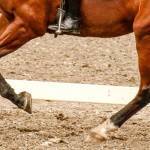Joint Care in Horses: Benefits of Hyaluronic Acid

In healthy joints, lubricin and hyaluronic acid serve as lubricating molecules that promote smooth, frictionless motion. Both molecules also mitigate the action of inflammatory mediators within the joint and protect articular cartilage from degeneration.
“Many athletic horses develop inflammation in their joints secondary to joint injury, repeated microtraumas from weight-bearing, or following injury to the soft tissues that support the joints,” explained Catherine Whitehouse, M.S., an advisor for Kentucky Equine Research.
While veterinarians often focus on the layers of cartilage that cap the ends of long bones, orthopedists from the College of Veterinary Medicine at Cornell University attest that lubricin and hyaluronic acid should also be addressed when considering the overall health of a horse’s joints.*
To this end, the researchers used three separate models of joint trauma to measure lubricin and hyaluronic acid levels in various joints. They found that a sustained loss of hyaluronic acid occurred in all models following injury. In contrast, lubricin increased, potentially to compensate for hyaluronic acid loss and to protect articular cartilage following injury.
Loss of hyaluronic acid in synovial fluid results in elevated friction, which is believed to contribute to increased cartilage wear and joint degeneration, according to the researchers.
“With this study in mind, the importance of maintaining appropriate hyaluronic acid levels within joints, particularly those suffering traumatic or inflammatory events, cannot be undervalued. This is why Kentucky Equine Research developed Synovate HA,” explained Whitehouse.
Synovate HA, a high molecular weight product available as an easy-to-administer liquid, helps prevent the loss of hyaluronic acid within joints.
*Peal, B.T., R. Gagliardi, J. Su, et al. 2020. Synovial fluid lubricin and hyaluronan are altered in equine osteochondral fragmentation, cartilage impact injury and full-thickness cartilage defect models. Journal of Orthopedic Research, doi: 10.1002/jor.24597.








